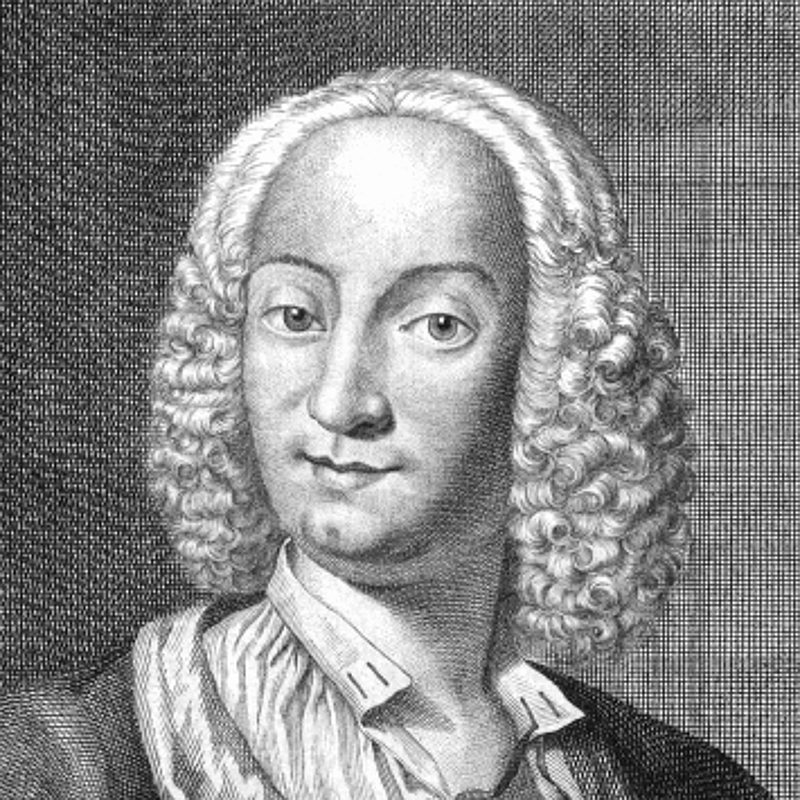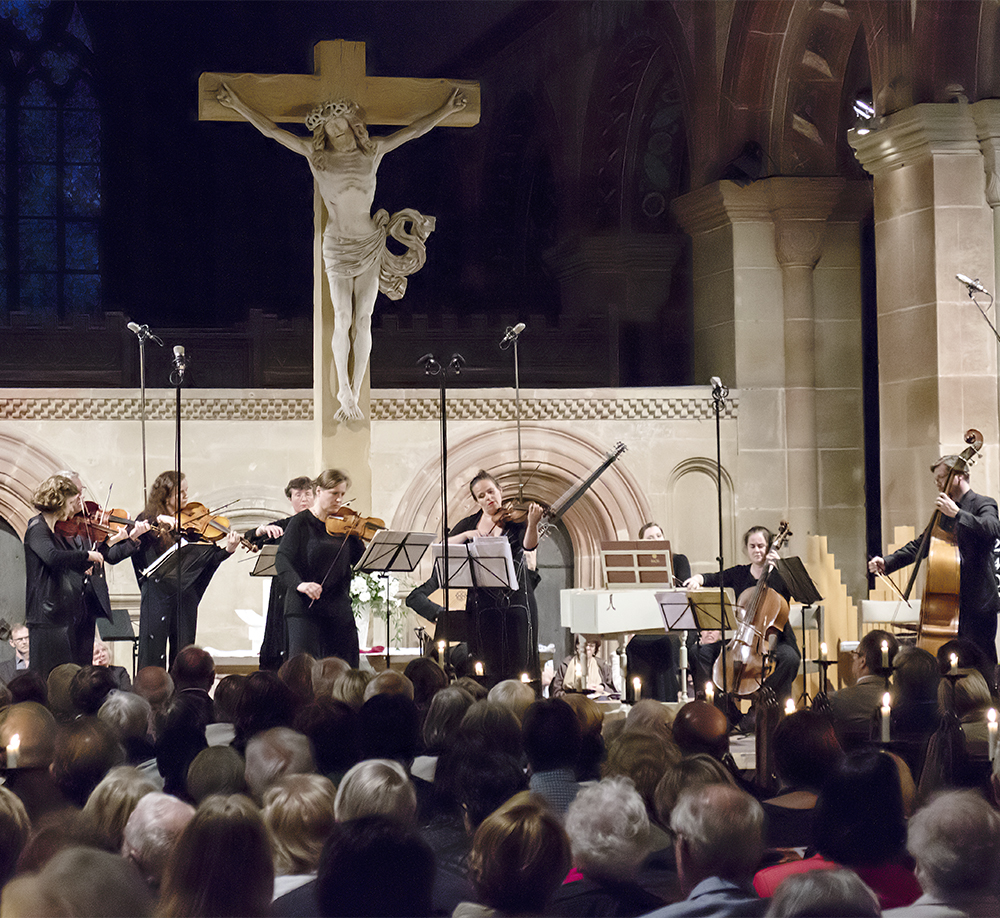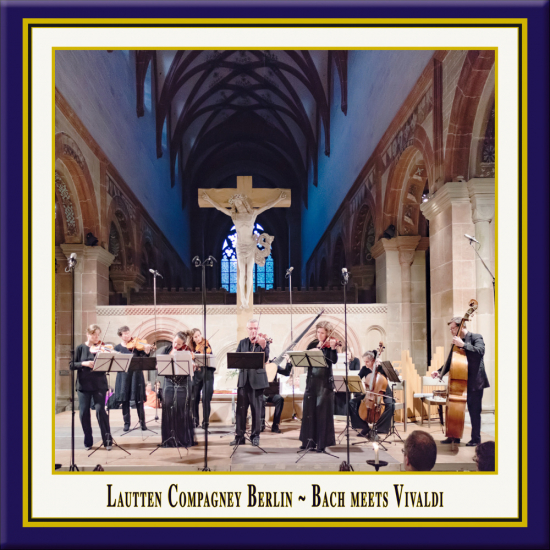Bach meets Vivaldi
Bach meets Vivaldi
The Lautten Compagney Berlin plays
according to the traditions of the time
Johann Sebastian Bach (1685-1750):
Concerto in A Minor, BWV 1041 · Concerto in E Major, BWV 1042
Concerto in D Minor, BWV 1043
Antonio Vivaldi (1678-1741):
Concerto in G Minor, RV 157
Concerto in B Minor, RV 580 ("L'Estro Armonico", Op. 3, No. 10)
Concerto in D Minor, RV 565 ("L'Estro Armonico", Op. 3, No. 11)
Soloist: Julia Schröder (Violin)
Concertmistress: Birgit Schnurpfeil · Artistic Director: Wolfgang Katschner
A live recording from the church of the German
UNESCO World Heritage Site Maulbronn Monastery
HD Recording · DDD · Duration: c. 67 Minutes
Also available on MP3 here:



T
he Concerto for Two Violins, Strings, and Continuo in D minor, BWV 1043, also known as the Double Violin Concerto, is perhaps one of the most famous works by Johann Sebastian Bach and considered among the best examples of the work of the late Baroque period. Bach may have written it between 1717 and 1723 when he was the Kapellmeister at the court of Anhalt-Köthen, Germany, though the work's performance materials for the Ordinaire Concerten that Bach ran as the Director of the Collegium Musicum in Leipzig are dated c. 1730–31. Later in 1739, in Leipzig, he created an arrangement for two harpsichords, transposed into C minor, BWV 1062. In addition to the two soloists, the concerto is scored for strings and basso continuo. The concerto is characterized by the subtle yet expressive relationship between the violins throughout the work. The musical structure of this piece uses fugal imitation and much counterpoint... From Wikipedia, The Free Encyclopedia
While the Violin Concerto in A minor, BWV 1041, is "generally thought to have been composed at Köthen in 1717–23", Christoph Wolff has argued that the work may have been written in Leipzig during Bach's time as director of the Collegium Musicum; John Butt also believes that Bach wrote it "probably soon after taking over the Leipzig Collegium Musicum in 1729". In any event, the only autograph source to survive are parts Bach copied out (along with other copyists) in Leipzig circa 1730 from a now lost score or draft... From Wikipedia, The Free Encyclopedia
The Violin Concerto in E major, BWV 1042, is a concerto for violin, strings, and continuo in three movements: Allegro (with ritornello), Adagio (with a ground bass) and Allegro assai (with an overall structure of a rondo). While there are two 18th-century scores, neither is autographed; however, Bach re-used the concerto as the model for his Harpsichord Concerto in D major, BWV 1054, found in his 1737–39 autographed manuscript of these works. The concerto is thought to have been written early in Bach's time in Weimar, when he was Konzertmeister at the Ducal Court... From Wikipedia, The Free Encyclopedia

L'estro armonico (the harmonic inspiration), Antonio Vivaldi's Op. 3, is a set of 12 concertos for stringed instruments, first published in Amsterdam in 1711. Vivaldi's Twelve Trio Sonatas, Op. 1, and Twelve Violin Sonatas, Op. 2, only contained sonatas, thus L'estro armonico was his first collection of concertos appearing in print. It was also the first time he chose a foreign publisher, Estienne Roger, instead of an Italian. Each concerto was printed in eight parts: four violins, two violas, cello and continuo. The continuo part was printed as a figured bass for violone and harpsichord. The concertos belong to the concerto a 7 format, that is: for each concerto there are seven independent parts. In each consecutive group of three concertos, the first is a concerto for four violins, the second for two violins, and the third a solo violin concerto. The cello gets solistic passages in several of the concertos for four and two violins, so that a few of the concertos conform to the traditional Roman concerto grosso format where a concertino of two violins and cello plays in contrast to a string orchestra. L'estro armonico pioneered orchestral unisono in concerto movements. Vivaldi composed a few concertos specifically for L'estro armonico, while other concertos of the set had been composed at an earlier date. Vivaldi scholar Michael Talbot described the set as "perhaps the most influential collection of instrumental music to appear during the whole of the eighteenth century". L'estro armonico (the harmonic inspiration) was published as Antonio Vivaldi's Op. 3 in Amsterdam in 1711. Vivaldi's Op. 1 and Op. 2 had only contained sonatas, thus L'estro armonico was his first collection of concertos appearing in print. It was also the first time Vivaldi chose a foreign publisher, Estienne Roger, instead of an Italian. Vivaldi composed a few concertos specifically for L'estro armonico, while other concertos of the set had been composed at an earlier date... From Wikipedia, The Free Encyclopedia
This concert took place in the church of the Maulbronn monastery in Germany. Built in the 12th century, the Maulbronn monastery with its Romanesque-Gothic basilica is considered as the most complete preserved medieval monastery north of the Alps. The monastery has been a UNESCO World Heritage Site since 1993. It's one of 60 historic monuments in the Germany's Southwest. The "State Organisation for Palaces and Gardens of Baden-Württemberg" (in German: "Staatliche Schlösser und Gärten Baden-Württemberg") makes accessible, communicate, develops and preserves these state-owned historic monuments with the aim of preserving the authenticity of the cultural heritage, filling them with life and preserving them for future generations. Detailed information about these unique "Soundscapes" can be found at: www.schloesser-und-gaerten.de


Soloist: Julia Schröder (Violin)
lautten compagney Berlin:
2nd Solo Violin & Concertmaster ~ Birgit Schnurpfeil
Violin ~ Matthias Hummel, Daniela Gubatz · Viola ~ Bettina Ihrig
Violin / Viola ~ Magdalena Schenk-Bader · Cello ~ Ulrike Becker
Double Bass ~ Alf Brauner · Harpsichord ~ Elina Albach
Lute ~ Johannes Gontarski
T
he lautten compagney Berlin is one of the most renowned and creative baroque instrument ensembles in Germany. Their concerts, under the artistic direction of Wolfgang Katschner, have fascinated audiences for three decades. With their infectious joy in performing and their innovative concepts, these 'early musicians' effortlessly translate the musical language of the Baroque to the present. The ensemble has received numerous awards for its exciting musical collaborations (2010 ECHO Klassik for 'Timeless', 2012 Rheingau Musik Preis). The lautten compagney is a regular guest at leading national and international concert halls and festivals, including Concertgebouw Amsterdam, Vienna Musikverein, Handel Festival Halle and Mosel Musikfestival. Twice a year, Wolfgang Katschner and the lautten compagney invite audiences to join them at AEQUINOX, a music festival for the equinox in Neuruppin, Brandenburg. Since 2014 the baroque musicians are also the ensemble in residence at the Festival Alter Musik Bernau.
The violinist Julia Schröder studied at the conservatory 'Gasteig' in Munich, at the Basel Music Academy and at the Schola Cantorum Basiliensis. Since 2004 Julia Schröder is the concert-mistress and director of the Basel Chamber Orchestra. Under her leadership the ensemble played in major concert halls in Europe such as the Vienna Musikverein, the Berlin Philharmonic, the Concertgebouw in Amsterdam, the Cité de la Musique in Paris and the Barbican Centre in London. In parallel she is a soloist accompanying artists such as Sol Gabetta, Andreas Scholl and Cecilia Bartoli. In 2010 she was called at the Freiburg Music Academy (D) to be a violin professor. She enjoys playing with Maurice Steger, Marcelo Nisinman, Gerard Wyss, Werner Güra and Christoph Berner. Julia Schröder is now a modern and universal musician, feeling comfortable in the world of modern violin as well as in the style of baroque play, while being also at ease in the improvisations of Jazz and she likes to play tango, too.
P
ublishing Authentic Classical Concerts entails for us capturing and recording outstanding performances and concerts for posterity. The performers, audience, opus and room enter into an intimate dialogue that in its form and expression, its atmosphere, is unique and unrepeatable. It is our aim, the philosophy of our house, to enable the listener to acutely experience every facet of this symbiosis, the intensity of the performance, so we record the concerts in direct 2-Track Stereo digital HD. The results are unparalleled interpretations of musical and literary works, simply - audiophile snapshots of permanent value. Flourishing culture, enthralling the audience and last but not least also you the listener, are the values we endeavor to document in our editions and series.
The concerts at the UNESCO World Heritage Maulbronn Monastery supply the ideal conditions for our aspirations. It is, above all, the atmosphere of the romantic, candle-lit arches, the magic of the monastery in its unadulterated sublime presence and tranquillity that impresses itself upon the performers and audience of these concerts. Renowned soloists and ensembles from the international arena repeatedly welcome the opportunity to appear here - enjoying the unparalleled acoustic and architectural beauty of this World Heritage Site, providing exquisite performances of secular and sacred music, documented by us in our Maulbronn Monastery Edition.
Andreas Otto Grimminger & Josef-Stefan Kindler, K&K Verlagsanstalt
Johann Sebastian Bach (1685-1750)
Concerto in D Minor, BWV 1043
for 2 Violins, Strings and Basso continuo
Solo Violins: Birgit Schnurpfeil & Julia Schröder
1. I. Vivace [3:28] ~ 2. II. Largo ma non tanto [6:11]
3. III. Allegro [4:36]
Antonio Vivaldi (1678-1741)
Concerto in B Minor, RV 580
No. 10 from "L'Estro Armonico", Op. 3
for 4 Violins, 2 Viols and Basso continuo
4. I. Allegro [3:38] ~ 5. II. Largo - Larghetto [1:44]
6. III. Allegro [3:14]
Johann Sebastian Bach (1685-1750)
Concerto in A Minor, BWV 1041
for Violin, Strings and Basso continuo
Solo Violin: Julia Schröder
7. I. Allegro [3:42] ~ 8. II. Andante [6:05]
9. III. Allegro assai [3:35]
Antonio Vivaldi (1678-1741)
Concerto in D Minor, RV 565
No. 11 from "L'Estro Armonico", Op. 3
for 2 Violins, Cello, Strings and Basso continuo
Solo Violins: Birgit Schnurpfeil & Matthias Hummel
10. I. Allegro - Adagio e spiccato - Allegro [3:55]
11. II. Largo e spiccato [2:23] ~ 12. III. Allegro [2:21]
Antonio Vivaldi (1678-1741)
Concerto in G Minor, RV 157
for Strings and Basso continuo
13. I. Allegro [1:53] ~ 14. II. Largo [1:35]
15. III. Allegro [2:09]
Johann Sebastian Bach (1685-1750)
Concerto in E Major, BWV 1042
for Violin, Strings and Basso continuo
Solo Violin: Julia Schröder
16. I. Allegro [7:07] ~ 17. II. Adagio [6:04]
18. III. Allegro assai [2:41]
19. Applause [0:40]
A concert recording to 'Direct 2-Track Stereo Digital HD'
from the church of the German UNESCO World Heritage Site Maulbronn Monastery,
recorded, released & created
by Andreas Otto Grimminger & Josef-Stefan Kindler
in cooperation with Sebastian Eberhardt,
Klosterkonzerte Maulbronn ("Maulbronn Monastery Concerts").
Concert Date: May 26, 2017
Sound & Recording Engineer: Andreas Otto Grimminger
Mastering: Andreas Otto Grimminger & Josef-Stefan Kindler
Photography: Josef-Stefan Kindler
Artwork & Coverdesign: Josef-Stefan Kindler

The UNESCO World Heritage Site Maulbronn Monastery
This concert took place in the church of the Maulbronn monastery in Germany. Built in the 12th century, the Maulbronn monastery with its Romanesque-Gothic basilica is considered as the most complete preserved medieval monastery north of the Alps. The monastery has been a UNESCO World Heritage Site since 1993. It's one of 60 historic monuments in the Germany's Southwest. The "State Organisation for Palaces and Gardens of Baden-Württemberg" (in German: "Staatliche Schlösser und Gärten Baden-Württemberg") makes accessible, communicate, develops and preserves these state-owned historic monuments with the aim of preserving the authenticity of the cultural heritage, filling them with life and preserving them for future generations. Detailed information about these unique "Soundscapes" can be found at: www.schloesser-und-gaerten.de

An audiophile snapshot of permanent value
Publishing Authentic Classical Concerts entails capturing and recording outstanding performances and concerts for posterity. The performers, audience, opus and room enter into an intimate dialogue that in its form and expression, its atmosphere, is unique and unrepeatable. It is the aim, the philosophy of K&K, to enable the listener to acutely experience every facet of this symbiosis, the intensity of the performance, so they record the concerts in direct 2-Track Stereo digital HD. The results are unparalleled interpretations of musical and literary works, simply - audiophile snapshots of permanent value. This concert took place in the church of the Maulbronn monastery in Germany. Built in the 12th century, the Maulbronn monastery with its Romanesque-Gothic basilica is considered as the most complete preserved medieval monastery north of the Alps.





An audiophile snapshot of permanent value
15. March 2018 - 11:14 — kuk-art.comArkiv Music - The source for Classical Music